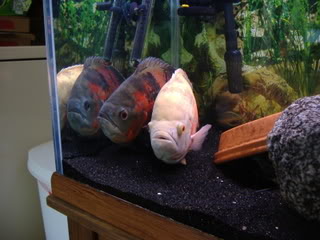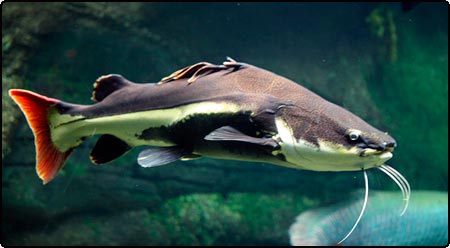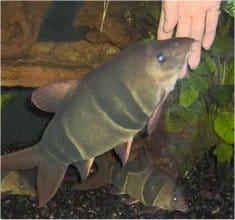Age old question which everyone has their opinion on but what is the Tropical Fish Site view point on stocking levels in your fish tank? Before looking at the considerations, take a look at our fish tank size calculator to work out the actual size of your aquarium. The first thing we need to consider is the type of fish we are keeping as some fish need to be over stocked in order to reduce targeted aggression within the group. Although this is often frowned upon, over stocking rift valley cichlids such as Malawi Cichlids and Tanganyika Cichlids is the best way of keeping these types of fish.
Before taking a formula and applying it exactly, we also have to consider what it is we are actually trying to work out. Ultimately the fish needs to be able to swim comfortably in the aquarium so total length of any one fish should always be half the width of the aquarium to ensure it is able to turn around properly. For example, an Oscar reaching 12-14 inches should be in a 2 foot deep aquarium, which gives the full grown adult enough room to turn around without having to perform a 3 or 5 point turn every time it gets to one end of the tank and wishes to turn around.

We must also consider the waste a fish will produce, if we take a messy cichlid such as the Jack Dempsey then these can get to 10 inches in length and although this is big, they will produce a huge amount more waste than say 10x one inch fish such as the all time classic Neon Tetra. This is because the total body mass of the Jack Dempsey is so much greater than that of 10 of the tetra fish.
On the same note as the waste a fish produces, you must take in to account the filtration you will be offering the fish. Over filtration is always better than under filtration or having a filter which is rated at the tank size. For example on our Malawi fish tank, the filtration was 800 litres worth for a 240 litre tank. A little bit over kill, indeed, but it’s better to have too much than not enough. If you are in a position where filtration is on the border of the size of tank then you must also consider the bio-load which the filter can handle.
You are going to be putting décor such as rocks and gravel, not to mention plants and other things which will take up space in the aquarium so if you are going to have a lot of décor then then this detracts from the actual volume of water have left available in the fish tank.
The final consideration when deciding upon the stocking levels of your tank should be the size of the fish. Stupid thing to say I hear you scream! But, this is the size of the fully grown adult fish and not the tiddler which you see in the fish store. A good example of this is the Red Tail Catfish – they can grow up to 2 foot in the first 12 months and end up being 3-4 foot in length which is too big for most home aquariums!

We have produced and will continue to produce tropical fish profiles to help and advise on the size of adult fish and appropriate tank sizes for them. Please always do your research before taking the plunge and buying a cute fish at the store without finding out a bit about it and how big it will get and how quickly it will get that big. The ever popular clown loach can and will reach 12 inches (they are amazing at that size but rarely seen this big!) however they can take a good 10 years to get this big which is a very long time so although you should plan for this, chances are you will have a larger tank or different arrangement 10 years down the line. Most good stores will ask such questions as your tank size, what you are currently keeping etc. Not to be nosy or patronising but simply for the welfare of the fish which I agree should always happen.

As a rule of thumb you could say that you can have 1 inch of fish per 4 litres of water but there are the other considerations to take in to account which we have listed above. So this rule generally applies to community fish which do not get bigger than 1-2 inches. So if you had say a 240 litre tank you could comfortably house around 40-50 tetras in there or other small community fish such as barbs or even livebearers. Don’t forget though that you are always likely to have your “core” fish such as the bristlenose pleco, this still counts in your allowance. It is not an exact science though because in the same 4 foot 240 litre tank you can just about comfortably fit 1 or 2 Oscar fish which although they are only 12 inches long so should be able to fit a single one in a 48 litre tank, I don’t think it would physically fit!
For our same 240 litre tank, as I mentioned at the start, if we were to fill it with Malawi cichlids which can top out at 4 inches, in theory we could fit 15 fish. I would recommend you didn’t stock any less than 20 though so as to even out aggression and a comfortable number should be around 25, maybe 30 depending on the types of Malawi fish they are and taking in to account the filtration running on the tank.
As you can see, there are so many different possibilities and factors to take in to consideration that making up a formula and making it an exact science simply isn’t possible. Best advise would be to ask around and do a bit of research on the fish, you will soon become aware of what levels of fish works and what doesn’t as you will be able to see quite quickly if your tank is over stocked and taking water parameter tests results weekly will be an indicator of you reaching your peak. As a general rule of thumb, add the fish gradually and you will find where the limit is. This may make you want to go and buy another tank though when you hit it, and so the addiction goes on…..!


Related Posts
A Deeper Look In To Loach Fish Species
How Much Salt Should I Add To My Freshwater Aquarium
Everything You Need To Know About Using T5 Lights For Your Aquarium